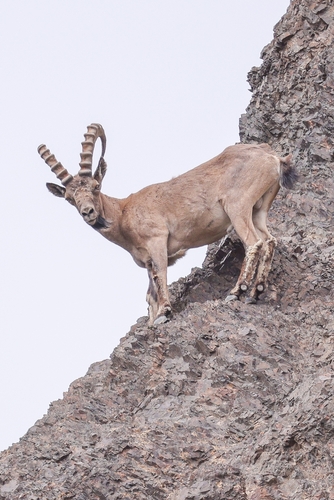
Siberian Ibex
The Siberian ibex, with its majestic spiraled horns and resilient nature, thrives in Central Asia's rocky highlands. Expert climbers, these herbivores navigate challenging terrains, playing a crucial role in their ecosystem by maintaining plant diversity and serving as prey for predators.
29.94 - 99.79 kg
Weight
Length: 1.2954 - 1.651 m; Height: 66 - 109 cm
Size
Brown, Grey, Black
Color
2 years
Age of Sexual Maturity
5-8 months
Age of Weaning
43.5 mph
Top Speed
Near Threatened
Conservation Status
Decreasing
Population Trend
Characteristics
Capra sibirica, commonly known as the Siberian ibex, is a robust wild goat native to the mountainous regions of Central Asia. It is distinguished by its impressive, backward-curving horns, which can reach up to 140 cm in males. These ibexes are adapted to steep, rugged terrains and are skilled climbers. They have a thick, woolly coat for insulation against harsh climates and exhibit social behavior, often forming herds.
Distribution Range of the Siberian Ibex
Capra sibirica, commonly known as the Siberian ibex, is native to Central Asia. Its geographical distribution includes countries such as Kazakhstan, Kyrgyzstan, Mongolia, Tajikistan, Uzbekistan, northern India, Pakistan, and western China. The species can also be found in the mountainous regions of Afghanistan and parts of Russia.
Siberian Ibex's Habitat
Environmental Conditions
The Siberian ibex inhabits rugged mountainous terrains at elevations ranging from 500 to over 5,000 meters above sea level. These regions typically have a continental climate characterized by cold winters and warm summers. The ibex prefers steep, rocky slopes and cliffs where it can effectively escape predators.
Ecological Niche
Capra sibirica is highly adapted to alpine and subalpine environments. It is a grazer and browser, feeding on grasses, shrubs, and lichens. The ibex plays a role in the ecosystem by maintaining vegetation balance and serving as prey for large carnivores such as snow leopards and wolves. Its adaptations include strong, curved horns for defense and navigating the rocky terrain, as well as a thick coat to withstand harsh weather conditions.
Copyright @ Nature Style Limited. All Rights Reserved.
 English
English